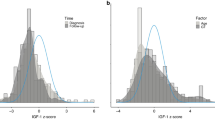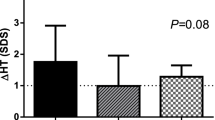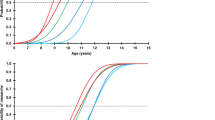Abstract
Intrauterine growth retardation (IUGR) is one of the major causes of short stature in childhood. Although postnatal catch-up growth occurs in the majority of IUGR children, approximately 20% of them remain permanently short. The mechanisms that allow catch-up growth or, on the contrary, prevent IUGR children from achieving a normal height are still unknown. Our aim was to investigate whether intrauterine reprogramming of hypothalamic-pituitary-adrenal axis may be involved in postnatal growth retardation of IUGR children through a modulation of the function of the IGF system. Anthropometry, IGF system assessment, cortisol measurement, and lipid profile evaluation were performed in 49 IUGR children. Children were subdivided into two groups according to their actual height corrected for midparental height: CG (catch-up growth) group, 19 children with corrected height ≥0 z-score; and NCG (noncatch-up growth) group, 30 subjects with corrected height <0 z-score. CG children showed significantly higher birth weight (p < 0.005) and body mass index (p < 0.05). No significant differences in IGF-I, IGF-II, IGF binding protein (IGFBP)-1, IGFBP-3, soluble IGF-II receptor levels (IGF2R), IGF-II/IGF2R ratio, and relative amounts of IGFBP-3 circulating forms were found between CG and NCG children. None of the IGF system-related variables correlated with anthropometric indices. NCG children showed significantly higher concentrations of cortisol (p < 0.005) and cortisol levels resulted inversely to birth weigh (r = −0.34, p < 0.05), birth length (r = −0.36, p < 0.05), and corrected height (r = −0.44, p < 0.01). Whereas total and HDL cholesterol concentrations were not significantly different in the two groups, LDL cholesterol levels were significantly higher in NCG children (p < 0.05), and five of 49 showed LDL cholesterol concentrations >3.4 mM (130 mg/dL). LDL cholesterol was inversely related to birth weight (r = −0.31, p < 0.05), corrected stature (r = −0.32, p < 0.05), and actual height (r = −0.31, p < 0.05) and directly related to the levels of IGF2R (r = 0.44, p < 0.01). Reanalysis of 15 of 30 IUGR newborns in whom we previously reported an inverse relationship between cord blood cortisol levels and first trimester length gain (r = −0.54, p < 0.005) showed that the relative amount of the IGFBP-3 18-kD fragment was related inversely to cortisol (r = −0.67, p < 0.01) and directly to early postnatal growth (r = 0.65, p < 0.05). Our results suggest that catch-up growth in IUGR children might be affected by intrauterine reprogramming of hypothalamic-pituitary-adrenal axis, which may result in a permanent modification of the neuroendocrine response to stress: children with increased cortisol secretion may be at higher risk of growth failure. During the neonatal period cortisol might act by limiting IGFBP-3 proteolysis and, therefore, reducing IGF bioavailability.
Similar content being viewed by others
Log in or create a free account to read this content
Gain free access to this article, as well as selected content from this journal and more on nature.com
or
Abbreviations
- CG:
-
catch-up growth
- HPAA:
-
hypothalamic-pituitary-adrenal axis
- IGF2R:
-
soluble IGF-II/mannose-6-phosphate receptor
- IUGR:
-
intrauterine growth retardation
- MPH:
-
midparental height
- NCG:
-
noncatch-up growth
- IGFBP:
-
IGF binding protein
- CV:
-
coefficient of variation
References
Fitzhardinge PM, Stevan EM 1972 The small for date infant. I. Later growth patterns. Pediatrics 49: 671–681
Karlberg J, Albertsson-Wikland K 1995 Growth in full-term small-for-gestational-age infants: from birth to final height. Pediatr Res 38: 733–739
Leger J, Noel M, Limal KM, Czernichow P 1996 Growth factors and intrauterine growth retardation. II. Serum growth hormone, insulin-like growth factor-I, and IGF-binding protein-3 levels in children with intrauterine growth retardation compared with normal control subjects: prospective study from birth to two years of age. Pediatr Res 40: 101–107
Cianfarani S, Germani D, Rossi P, Rossi L, Germani A, Ossicini C, Zuppa A, Argirò G, Holly JMP, Branca F 1998 Intrauterine growth retardation: evidence for the activation of the insulin-like growth factor (IGF)-related growth-promoting machinery and the presence of a cation-independent IGF binding protein-3 proteolytic activity by two months of life. Pediatr Res 44: 374–380
Jones JL, Clemmons DR 1995 Insulin-like growth factors and their binding proteins. Endocr Rev 16: 3–34
Baxter RC, Martin JL, Beniac VA 1989 High molecular weight insulin-like growth factor complex; purification and properties of the acid-labile subunit from human serum. J Biol Chem 264: 11843–11848
Giudice LC, Farrell EM, Pham H, Lamson G, Rosenfeld RG 1990 Insulin-like growth factor binding proteins in maternal serum throughout gestation and in the puerperium: effects of a pregnancy-associated serum protease activity. J Clin Endocrinol Metab 71: 806–816
Hossenlopp P, Sergovia B, Lassarre C, Roghani M, Bredon M, Binoux M 1990 Evidence of enzymatic degradation of insulin-like growth factor-binding proteins in the 150K complex during pregnancy. J Clin Endocrinol Metab 71: 797–805
Blat C Villaudy J, Binoux M 1994 In vivo proteolysis of serum insulin-like growth factor (IGF) binding protein-3 results in increased availability of IGF to target cells. J Clin Invest 93: 2226–2229
Barker DJP, Winter PD, Osmond C, Margetts B 1989 Weight in infancy and death from ischemic heart disease. Lancet 2271: 577–580
Barker DJP, Hales CN, Fall CHD, Osmond C, Phipps K, Clark PMS 1993 Type 2 (non-insulin dependent) diabetes mellitus, hypertension and hyperlipidemia (syndrome X): relation to reduced fetal growth. Diabetologia 36: 62–67
Barker DJP 1997 Intrauterine programming of coronary heart disease and stroke. Acta Paediatr Suppl 423: 178–182
Levine S 1957 Maternal and environmental influences on the adrenocortical response to stress in weanling rats. Science 156: 258–260
Meaney MJ, Aitken DH, Sharma S, Viau V 1992 Basal ACTH, corticosterone and corticosterone binding globulin levels over the diurnal cycle, and age-related changes in hippocampal type I and type II corticosteroid receptor binding capacity in young and aged, handled and non handled rats. Neuroendocrinology 55: 204–213
Barbazanges A, Piazza PV, Le Moal M, Maccari S 1996 Maternal glucocorticoid secretion mediates long-term effects of prenatal stress. J Neurosci 16: 3943–3949
Dodic M, Peers A, Coghlan JP, Wintour M 1999 Can excess glucocorticoid, in utero, predispose to cardiovascular and metabolic disease in middle age?. Trends Endocrinol Metab 10: 86–91
Lesage J, Blondeau B, Grino M, Breant B, Dupouy JP 2001 Maternal undernutrition during late gestation induces fetal overexposure to glucocorticoids and intrauterine growth retardation, and disturbs the hypothalamo-pituitary adrenal axis in the newborn rat. Endocrinology 142: 1692–1702
Phillips DIW, Barker DJP, Fall CHD, Seckl JR, Whorwood CB, Wood PJ, Walker BR 1998 Elevated plasma cortisol concentrations: a link between low birth weight and the insulin resistance syndrome?. J Clin Endocrinol Metab 83: 757–760
Cianfarani S, Germani D, Rossi L, Argirò G, Boemi S, Lemon M, Holly JMP, Branca F 1998 IGF-I and IGF-binding protein-1 are related to cortisol in human cord blood. Eur J Endocrinol 138: 524–529
Lubchenco LO, Hansman C, Dressler M, Boyd R 1963 Intrauterine growth as estimated from liveborn birth weight data at 24 to 42 wk of gestation. Pediatrics 32: 793–800
Tanner JM, Whitehouse RH 1976 Clinical longitudinal standards for height, weight, height velocity, weight velocity and stages of puberty. Arch Dis Child 51: 170–179
Lubchenco LO, Hansman C, Boyd R 1966 Intrauterine growth in length and head circumference as estimated from live births at gestational ages from 26 to 42 wk. Pediatrics 37: 403–408
Costello M, Baxter RC, Scottt RC 1999 Regulation of soluble insulin-like growth factor II/mannose 6-phsphate receptor in human serum: measurement by enzyme-linked immunosorbent assay. J Clin Endocrinol Metab 84: 611–617
Friedewald WT, Levy RJ, Fredrickson DS 1972 Estimation of the concentration of low-density-lipoprotein cholesterol in plasma without use of the preparative ultracentrifuge. Clin Chem 18: 499–502
Hatterssley AT, Tooke JE 1999 The fetal insulin hypothesis: an alternative explanation of the association of low birth weight with diabetes and vascular disease. Lancet 353: 1789–1792
Albertsson-Wikland K 1989 Growth hormone secretion and growth hormone treatment in children with intrauterine growth retardation. Swedish Paediatric Study Group for Growth Hormone Treatment. Acta Paediatr Scand Suppl 349: 35–41
Stanhope R, Preece MA, Hamill G 1991 Does growth hormone treatment improve final height attainment of children with intrauterine growth retardation?. Arch Dis Child 66: 1180–1183
de Waal WJ, Hokken-Koelega ACA, Stijnen T, de MuinckKeizer-Schrama SMPF, Drop SLS 1994 Endogenous and stimulated GH secretion, urinary GH excretion, and plasma IGF-I and IGF-II levels in prepubertal children with short stature after intrauterine growth retardation. Clin Endocrinol 41: 621–630
Boguszewski M, Rosberg S, Albertsson-Wikland K 1995 Spontaneous 24-hour growth hormone profiles in prepubertal small for gestational children. J Clin Endocrinol Metab 80: 2599–2606
de Zegher F, Maes M, Gargosky SE, Heinrichs C, Du Caju MV, Thiry G, De Schepper J, Craen M, Breysem L, Lofstrom A, Jonsson P, Bourguignon JP, Malvaux P, Rosenfeld RG 1996 High-dose growth hormone treatment of short children born small for gestational age. J Clin Endocrinol Metab 81: 1887–1892
Boguszewski M, Albertsson-Wikland K, Aronsson S 1998 Growth hormone treatment of short children born small-for-gestational-age: the Nordic Multicentre Trial. Acta Paediatr 87: 257–263
Houang M, Morineau G, Le Bouc Y, Fiet J, Gourmelen M 1999 The cortisol-cortisone shuttle in children born with intrauterine growth retardation. Pediatr Res 46: 189–193
Matthews SG 2000 Antenatal glucocorticoids and programming of the developing CNS. Pediatr Res 47: 291–300
Francois I, de Zegher F 1997 Adrenarche and fetal growth. Pediatr Res 41: 440–442
Lajic S, Wedell A, Bui TH, Ritzen EM, Holst M 1998 Long-term somatic follow-up of prenatally treated children with congenital adrenal hyperplasia. J Clin Endocrinol Metab 83: 3872–3880
Elias LL, Huebner A, Metherell LA, Canas A, Warne GL, Manca Bitti ML, Cianfarani S, Clayton PE, Savage MO, Clark AJ 2000 Tall stature in familial glucocorticoid deficiency. Clin Endocrinol 53: 423–430
Delany AM, Canalis E 1995 Transcriptional repression of insulin-like growth factor-I by glucocorticoids in rat bone cells. Endocrinology 136: 4776–4781
Swolin D, Brantsing C, Matejka G, Ohlsson C 1996 Cortisol decreases IGF-I messenger-RNA levels in human osteoblast-like cells. J Endocrinol 149: 397–403
Conover CA, Divertie GD, Lee PDK 1993 Cortisol increases plasma insulin-like growth factor binding protein-1 in humans. Acta Endocrinol 128: 140–143
Conover CA, Lee PDK, Riggs BL, Powell DR 1996 Insulin-like growth factor binding protein-1 expression in cultured human bone-cells: regulation by insulin and glucocorticoids. Endocrinology 137: 3295–3301
Cianfarani S, Germani D, Geremia C 1999 Cortisol levels are inversely related to the major fragment of IGFBP-3 (∼29 kDa) in IUGR children. A novel regulatory mechanism for perinatal growth?. Endocrinol Metab 12( suppl 2): 705( abstr 3)
Sas T, Mulder P, Hokken-Koelega A 2000 Body composition, blood pressure, and lipid metabolism before and during long-term growth hormone (GH) treatment in children with short stature born small for gestational age either with or without GH deficiency. J Clin Endocrinol Metab 85: 3786–3792
Tenhola S, Martikainen A, Rahiala E, Herrgard E, Halonen P, Voutilainen R 2000 Serum lipid concentrations and growth characteristics in 12-year-old children born small for gestational age. Pediatr Res 48: 623–628
Scott CD, Ballesteros M, Madrid J, Baxter RC 1996 Soluble insulin-like growth factor-II/mannose 6-phosphate receptor inhibits deoxyribonucleic acid synthesis in cultured rat hepatocytes. Endocrinology 137: 873–878
Scott CD, Weiss J 2000 Soluble insulin-like growth factor-II/mannose 6-phosphate receptor inhibits DNA synthesis in insulin-like growth factor II sensitive cells. J Cell Physiol 182: 62–68
Ong K, Kratzsch J, Kiess W, Costello M, Scott C, Dunger D 2000 Size at birth and cord blood levels of insulin, insulin-like growth factor-I (IGF-I), IGF-II, IGF-binding protein-1 (IGFBP-1), IGFBP-3, and the soluble insulin-like growth factor-II/mannose 6-phosphate receptor in term human infants. J Clin Endocrinol Metab 85: 4266–4269
Kobayashi T, Beuchat MH, Lindsay M, Frias S, Palmiter RD, Sakuraba H, Parton RG, Gruenberg J 1999 Late endosomal membranes rich in lysobisphosphatidic acid regulate cholesterol transport. Nat Cell Biol 1: 113–118
Mukherjee S, Maxfield FR 1999 Cholesterol: stuck in traffic. Nat Cell Biol 1: E37–E38
Author information
Authors and Affiliations
Corresponding author
Rights and permissions
About this article
Cite this article
Cianfarani, S., Geremia, C., Scott, C. et al. Growth, IGF System, and Cortisol in Children with Intrauterine Growth Retardation: Is Catch-up Growth Affected by Reprogramming of the Hypothalamic-Pituitary-Adrenal Axis?. Pediatr Res 51, 94–99 (2002). https://doi.org/10.1203/00006450-200201000-00017
Received:
Accepted:
Issue date:
DOI: https://doi.org/10.1203/00006450-200201000-00017
This article is cited by
-
Inadequate linear catch-up growth in children born small for gestational age: Influencing factors and underlying mechanisms
Reviews in Endocrine and Metabolic Disorders (2024)
-
A cluster-randomized trial of water, sanitation, handwashing and nutritional interventions on stress and epigenetic programming
Nature Communications (2024)
-
Liver transcriptome profiling and functional analysis of intrauterine growth restriction (IUGR) piglets reveals a genetic correction and sexual-dimorphic gene expression during postnatal development
BMC Genomics (2020)
-
Early postnatal alteration of body composition in preterm and small-for-gestational-age infants: implications of catch-up fat
Pediatric Research (2015)
-
Effect of intrauterine growth retardation on liver and long-term metabolic risk
International Journal of Obesity (2012)



